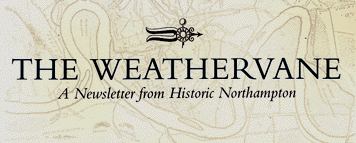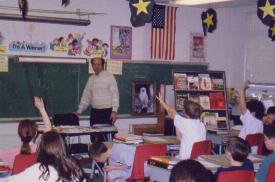

|


Weathervane Newsletter Summer 1998

Music Educator Makes History in the Classroom
In the late 18th century, a type of music proliferated that used triangles, squares and diamonds for notation instead of spheres. This style of music known as "shape note", in reference to this unusual notation, was a uniquely American form that represented musical renaissance in New England.
This music is now largely forgotten - and so is the fact that shape note music books were widely published in Northampton. Among Western Massachusetts residents were some of the form's most respected composers.
Local musician, Nicholas Kachulis, introduced students to this musical form last spring in a series of programs at two Northampton schools. Sponsored by Historic Northampton, this project was funded by the Northampton Arts Council with support from the Massachusetts Cultural Council.
Kachulis traveled to the Leeds and Bridge Street elementary schools to teach fifth graders about shape note music and the Yankee tunesmiths that created it. Following Kuchulis' classroom sessions, students were treated to a concert by Northampton Harmony, a quartet specializing in the Sacred Harp style of shape note singing.
Shape note music, says Kachulis, was a form of sacred music. The words are hymns set to a new melody, he said, each melody named for a beautiful place. A number of melodies were named for local areas: Montgomery, Montague, Florence, Chesterfield.
In the notation, the first three notes in a scale were each a different shape, the next three repeat the shape and the seventh note is a diamond. That makes the music easy to read, said Kachulis - a triangular note was either a C or an F, for example. It was music designed to be sung acapella. One group sings the melody while the others sing in close harmony. The singing was further complicated by "fugue-ing" or singing in rounds.
This type of call and response singing evolved as congregations participated more directly in church services. It was a method in which everyone could follow, regardless of their musical training.
Singing schools began in New England, with itinerant teachers traveling from town to town during the winter. Eventually the singing school teachers began to publish their own books. William Billings, a Northampton shape note musician who invented fugue-ing, published the first book in 1770. Besides Billings in Northampton, famous composers included Justin Morgan of West Springfield (who bred Morgan horses), Timothy Swann of Northfield and Elias Mann of Northampton.
Eventually the music died out as clergy and congregations began to favor more European forms of sacred music. However, the genre has been preserved by groups like Northampton Harmony and by the Hooks' Regular Sing in Amherst. Thanks to them and music educators like Kachulis, a new generation of school children can rediscover the musical legacy of their community.
Contents Historic Northampton.